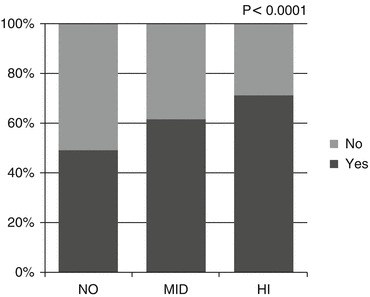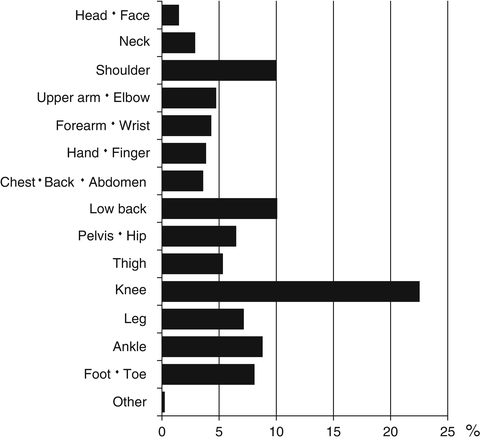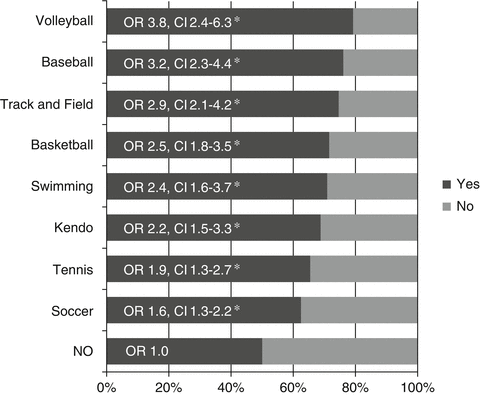(1)
Department of Orthopaedic Surgery, Medical Center, Japan Institute of Sports Sciences, Tokyo, Japan
Abstract
Low back disorders may have a serious effect on an athlete’s performance. In previous reports, low back pain has been particularly associated with sports activities during youth. In addition, low back disorders such as lumbar disk degeneration have been associated with competitive sports activities. Furthermore, we reported that the incidence of lumbar disk degeneration among baseball players and swimmers was significantly higher than that of non-athletes. The relationships between positions in sports and low back disorders have also been also examined.
In this chapter we review these relationships, and also examine low back disorders of Japanese top athletes.
Keywords
Lumbar disk degenerationLumbar disk herniationSpondylolysisCompetitive sports32.1 Introduction
The lifetime prevalence of low back pain (LBP) in the general adult population is estimated to be 60–90 % (Hangai et al. 2008; Long et al. 1996; Trainor and Wiesel 2002). Accordingly, it is difficult to demonstrate that LBP is the result of sports injuries. However, LBP strongly affects an athlete’s performance, and proper recovery allows the athletes to return to their preinjury level of competition. There is no doubt that LBP is a major problem for athletes. Lumbar disk herniation, disk degeneration, and spondylolysis are the most common low back disorders associated with LBP in athletes. On the other hand, despite athletes typically being highly motivated to return to sports activity, a specific pain generator is not always found. Recently, such disorders were categorized as nonspecific LBP. It is reported that more than 80 % of low back disorders are included in nonspecific LBP.
In this chapter, we review the literature concerning LBP and low back disorders in athletes.
32.2 The Relationships Between Sports Activities and Low Back Disorders
The relationship between sports activities and LBP has largely focused on the effect of sports during youth (Harreby et al. 1999; Kovacs et al. 2003; Kujala et al. 1996; Mattila et al. 2008; Skoffer and Foldspang 2008). Sato et al. reported that in a total of 43,630 Japanese pupils, the no-sports group reported a 21.3 % incidence of LBP, while, in the sports group, 34.9 % experienced LBP (Sato et al. 2010). Sward et al. reported that the incidence of LBP in elite gymnasts (79 %) was significantly higher than that of the control group (38 %) (Sward et al. 1990). We also documented a relationship between LBP and competitive sports activities during youth (Hangai et al. 2010a). The participants in our study were 4667 new university students who, from 2004 to 2006, answered a questionnaire concerning LBP and their participation in competitive sports. The participants were divided into a “no” group (NO), a middle group (MID), and a high group (HI) based on the duration of their participation in competitive sports. There were statistically significant linear associations in the NO, MID and HI groups with 50.0, 61.8, and 71.7 % of the students experiencing LBP, respectively (Fig. 32.1).


Fig. 32.1
Linear associations between low back pain experienced during the students’ lifetime and 3 groups based on the duration of sports experience (Hangai et al. 2010a). No no sports, MID middle sports experience, HI high sports experience
It has been reported that lumbar spondylolysis is a fatigue fracture that causes pars interarticularis, and occurs during youth (Sairyo et al. 2003; Sakai et al. 2010; Wiltse 1962). Imamoto et al. reported that an abnormality such as spondylolysis is the most significant risk factor for LBP in high school and college football players, and that disk space narrowing and spinal instability are significant risk factors for LBP in athletes with high levels of athletic activity, such as a college football players (Iwamoto et al. 2004).
Therefore, we suggest that excessive exposure to competitive sports activities is associated with LBP and low back disorders. This influence appears to be particularly strong during youth. On the other hand, some studies have found that competitive sports activities are not associated with LBP (Balague et al. 1993; Feldman et al. 2001; Mogensen et al. 2007).
32.3 Low Back Disorders of Top Athletes
We investigated the disorders of top athletes who visited the orthopedics department of the Japan Institute of Sports Sciences (JISS) from 2008 to 2012 (Hangai et al. 2013). In Fig. 32.2, the incidence by anatomical region is shown. Of 7,873 disorders reported, disorders of the knee joint were the most frequent (22.6 %), followed by low back disorders (10.1 %). Of the low back disorders, nonspecific LBP was reported most frequently at 33.6 %, followed by lumbar disc herniation at 18.9 % and lumbar disc degeneration at 17.0 %. Thus, lumbar disk disorders are strongly associated with LBP in athletes.


Fig. 32.2
Incidence by anatomical region of disorders in athletes who visited the Japan Institute of Sports Sciences (Hangai et al. 2013)
Other studies report that the incidence of spondylolysis for Japanese professional soccer and baseball players with or without pain is much higher (30 %), at >5 times the incidence that occurs in the general Japanese population (Matsumoto 2006; Sakai et al. 2009, 2010). However, in our study of JISS, spondylolysis was reported by 12.7 % of participants with low back disorders. The mean age of our participants (22.9 years) was older than the age considered susceptible to the development of spondylolysis. When spondylolysis is complete, the pain often disappears, which may have influenced our findings.
32.4 The Relationships Between Type of Sport, Position, and Low Back Disorders
In our study of new university students mentioned above, we selected students who had participated in the same sport for 5 or more years, and categorized the students according to the type of sport. Differences in LBP among the groups were analyzed using logistic regression with the NO as the reference group. All 8 sports groups that we analyzed experienced LBP at a significantly higher rate than the NO group, with the highest odds ratios in the volleyball group (3.8) (Fig. 32.3).


Fig. 32.3




Logistic regression analysis of low back pain during the students’ lifetime by sport group (Hangai et al. 2010a). OR odds ratio, CI 95 % confidence interval. * P < .05
Stay updated, free articles. Join our Telegram channel

Full access? Get Clinical Tree








